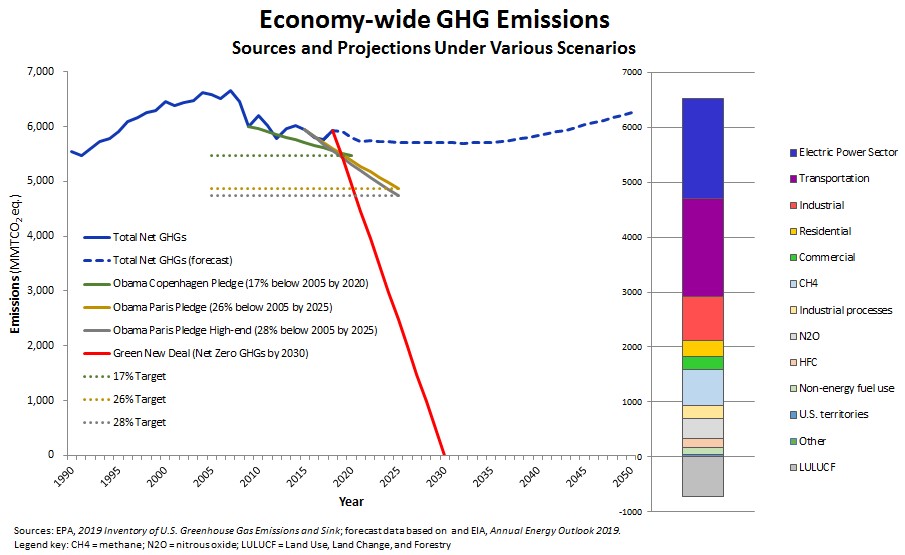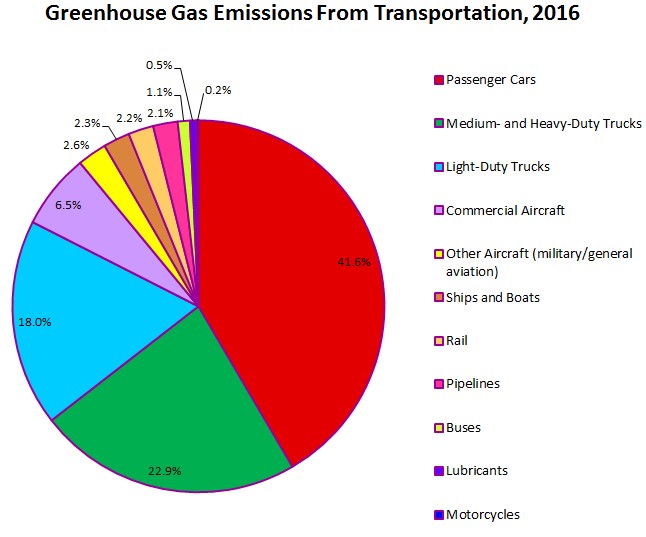Virtually unheard of just 3 months ago, the Green New Deal (GND) has burst into the national debate faster and more furiously than any issue in recent memory. As controversial as the ideas in the GND are, advocates on both sides seem to agree that the proposal would entail a radical and unprecedented transformation of America’s economic and energy systems.
As U.S. Chamber Executive Vice President and Chief Policy Officer Neil Bradley stated, this approach stands in stark contrast to the free enterprise system that has helped make America the world’s most advanced and vibrant economy:
“There are two competing approaches to addressing our country’s challenges such as climate change, healthcare and income inequality. In one approach, as exemplified by the “Green New Deal,” government asserts control over most of our economy, passing along the enormous costs and bureaucratic inefficiencies to everyday Americans. In the other, our robust system of free enterprise rises to the challenge, tapping into our deep well of ingenuity and creativity. This is the approach that built our nation and made us a land of opportunity for all, in stark contrast to failed socialist policies that have plagued many other countries over time.”
Moreover, proposing such a grossly unworkable scheme does little to solve the problem. The proposal’s grandiosity may serve only to divert attention from the things we are doing and realistically can do, and do well.
Nonetheless, the authors and supporters of the GND have given every indication that they are serious about its advancement. We take them at their word, and therefore, an equally serious look at what the GND is and could mean for the American economy is not only warranted, but necessary. While the GND is ultimately an all-encompassing economic policy that would institute major changes on issues from education and labor to healthcare, finance, housing, agriculture, and more, we will focus on what we know best: energy. When it comes to energy, the GND’s fatal flaw is its failure to recognize that decarbonizing the economy is fundamentally a technology challenge, and not something that can simply be regulated into existence.
Specifically, the Green New Deal calls for the U.S. to achieve net-zero greenhouse gas emissions (GHG) through a 10-year “national mobilization effort” to eliminate GHGs from all economic sectors—electricity generation, transportation, agriculture, buildings, and manufacturing, industry—you name it.
This focus on economy-wide GHGs is important, as the chatter associated with the GND has focused primarily on its call for the United States to generate 100% of its electricity from renewable sources by 2030 (non-hyrdo renewables—mostly wind and solar—currently account for only about 10% of generation), so let’s start with that.
The notion of a 100% renewable electric grid by 2030 is, to put it gently, wildly unrealistic. A team of respected academics explored this possibility and published a paper concluding that such a goal would be impossible by 2050, to say nothing of 2030. Even if emissions-free nuclear energy were eligible under such a mandate—a major point of dispute and confusion among GND advocates—such a goal would still be extremely costly and unobtainable.
But the GND doesn’t stop with the power sector; it targets the entire economy. While Americans tend to associate emissions with activities such as electricity generation and vehicles, the breadth of activities that contribute to GHG emissions is as diverse as our economy itself. The graphic below displays the major source categories of GHGs, and illustrates the incredibly extreme, goals of the GND. The blue line shows historical, economy-wide GHG emissions from 1990 as well as a current policies projection through 2050. As you can see, emissions have remained generally flat—an impressive achievement in and of itself given the growth of the U.S. economy and population. By contrast, the red line illustrating the GND would entail a sudden and dramatic downward cliff on its way to zero. (Lines showing the Obama Administration’s goals of a 17% reduction in net emissions by 2020 and 26% to 28% by 2025 are included for refrerence.)

Consider that even if the aforementioned effort to transition to a 100% renewable electricity system were successful, it would only address about 30% of economy-wide emissions. We would still have to eliminate emissions from the other 70% of sources—transportation, industry, residential and commercial buildings, as well as non-CO2 sources such as methane (think cow “emissions”) and HFCs (air conditioning and refrigeration). In other words, every nook and cranny of the economy.
Moreover, each of these sector categories are comprised of numerous subsector sources, each with their own unique circumstances and challenges when it comes to emissions. Consider transportation, for example. We would not only have to electrify or otherwise eliminate all passenger cars and trucks, but also heavy-duty trucks such as tractor-trailers, railroads, ships and boats, and even airplanes. In most of these cases, practical technological solutions have not even been conceived, let alone researched, developed, and implemented.
 Remember, transportation is just one sector. Emissions from manufacturing and agriculture would also have to be eliminated. The categories of impacted activities is seemingly endless—from landfills to the manufacture of asphalt for roads to rubber for car tires to synthetic fibers and plastics for countless uses, to glass manufacturing, fertilizer production, food processing, cement and fertilizer, and on and on (for a complete, detailed list of emissions sources and amounts, see EPA’s just-released 2019 Inventory of U.S. Greenhouse Gas Emissions and Sinks). In short, energy is everywhere.
Remember, transportation is just one sector. Emissions from manufacturing and agriculture would also have to be eliminated. The categories of impacted activities is seemingly endless—from landfills to the manufacture of asphalt for roads to rubber for car tires to synthetic fibers and plastics for countless uses, to glass manufacturing, fertilizer production, food processing, cement and fertilizer, and on and on (for a complete, detailed list of emissions sources and amounts, see EPA’s just-released 2019 Inventory of U.S. Greenhouse Gas Emissions and Sinks). In short, energy is everywhere.
It is not just necessary to power vehicles and help keep the lights on; it is essential to producing and delivering the modern conveniences and necessities that we take for granted.
It is also important to remember that policies such as these must be considered in a global context. Even if through some miracle the U.S. was in fact successful at achieving net-zero GHGs by 2030, emissions growth in the rest of the world would more than offset reductions here at home. Using the “current policies” scenario of the Climate Action Tracker, we estimate that global net GHG emissions will increase by more than 7.2 gigatons between 2017 and 2030. By comparison, net U.S. GHG emissions in 2017 were about 5.8 gigatons. In other words, every ton of CO2 equivalent that the United States would reduce under the GND would be more than offset by increased emissions elsewhere in the world.
Viewed another way, a cut of this magnitude during the 10-year period 2021 to 2030 would necessitate that the United States reduce total net GHG emissions equal to about six-and-a-half Germanys, or roughly one Germany every 18 months or so.
This is why the Chamber continues to emphasize that a truly effective and durable climate policy must focus more on innovation than regulation. Because the vast majority of GHG emissions growth is expected to come from developing countries where costly alternatives are not a viable option, development of affordable and globally scalable low emissions technologies is an absolute necessity. The good news is that several areas hold great promise to do just that. From advanced nuclear technologies to carbon capture and sequestration to large scale energy storage, the future is bright. With smart policies and a serious commitment of resources, that future will get here sooner rather than later.
In other words, the point of all of this is not to throw cold water on actions to address climate change. Rather, it is to remind that we cannot effectively do so if the public policy debate is unmoored from any semblance of reality. The GND fails this simple test.

